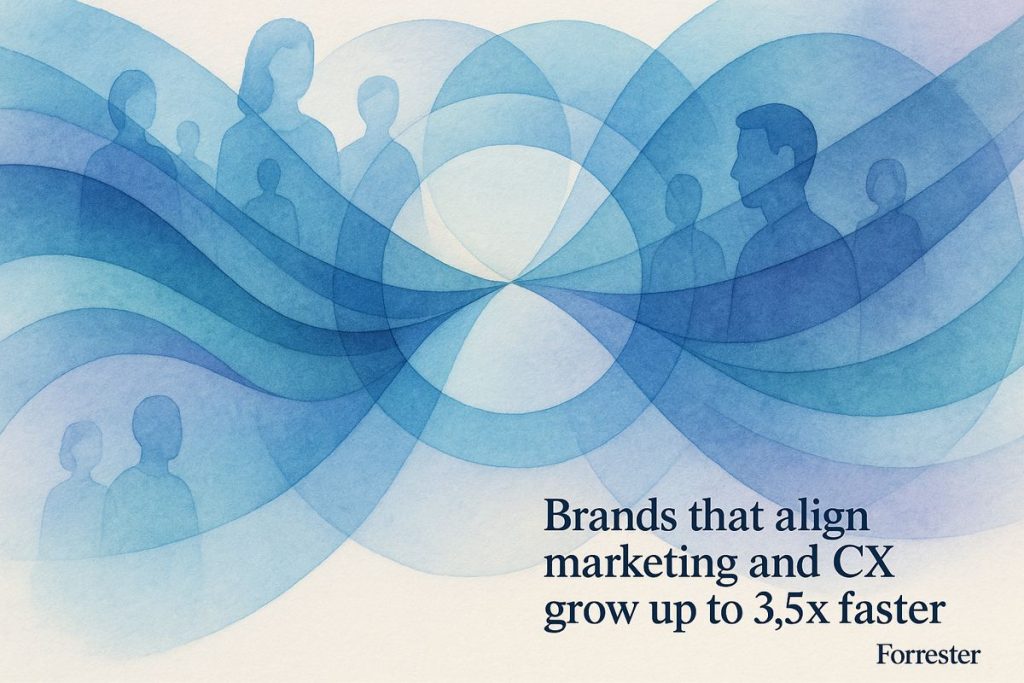Forrester’s Total Experience Score (TXS) checks if what brands promise in their marketing matches what customers really get. By mixing two big scores—the Brand Experience Index and the Customer Experience Index—TXS shows where brands shine and where they fail. If a company keeps its promises, it can grow much faster and win trust, but if it doesn’t, it risks losing both money and credibility. Forrester’s TXS uses tons of data and is hard to cheat, making it a powerful tool for honesty. Technology like Salesforce and Adobe helps companies bring their teams together and make customer experiences smoother and more real.
What is Forrester’s Total Experience Score (TXS) and why does it matter?
Forrester’s Total Experience Score (TXS) measures how closely a brand’s marketing promises align with the actual customer experience. By combining the Brand Experience Index (BX Index™) and Customer Experience Index (CX Index™), TXS exposes experience gaps, helping companies drive faster growth and build lasting credibility with customers.
The Elusive Art of Keeping Promises
Let’s not kid ourselves—aligning what marketing trumpets and what the customer actually experiences is a bit like herding caffeinated cats. I’ve watched more than one pharmaceutical launch veer off the rails because the sizzle outpaced the steak. Forrester, in its methodical, slightly obsessive fashion, rolled out the Total Experience Score (TXS) to slice through this fog. Is it a silver bullet? Maybe not. But it’s the most hyperspectral lens we’ve got for measuring where brands deliver, flounder, or—dare I say—catastrophically overpromise.
If you’ve ever agonized over whether your painstaking “customer-first” slogan matches reality, TXS offers a palimpsest of hope. It’s not your mother’s Net Promoter Score. Instead, it wrangles two heavyweight indices: the Brand Experience Index (BX Index™), which captures perceptions from both customers and the peanut gallery (noncustomers), and the Customer Experience Index (CX Index™), which puts actual experience under the microscope. Forrester’s methodology is built on a mountain of data—think over 300,000 survey respondents, 400 brands, 10 industries, and 13 countries. That’s not a drop in the ocean; it’s the Atlantic.
Sometimes, as I sip my burnt office coffee (ugh, the aroma lingers), I wonder: can a single score ever encapsulate the messiness of real-world experiences? Forrester seems to think so, and I’m cautiously optimistic.
Beneath the Hood: Decoding TXS
Here’s where it gets interesting. TXS isn’t stitched together with duct tape and hope. It uses an algorithm that actually weighs industry quirks and local idiosyncrasies—what plays well in Basel may bomb in Boston. This is particularly vital for pharma, where regulatory hurdles and Byzantine customer journeys are the norm (and where the stakes taste a lot less like vanilla).
The BX Index is all about the future; it tracks how magnetic your brand feels and whether the zeitgeist is on your side. The CX Index, in contrast, is a cold, hard look in the mirror: did the customer’s interaction with your company make them want to sing your praises, or run for the hills? The resulting TXS isn’t just a number—it’s a gap analysis, exposing where your brand’s poetry meets the prose of customer complaints.
Fun fact: Forrester zealously guards its scoring criteria, so companies can’t “buy” a higher TXS or sneakily massage the sample. As I learned the hard way in a past role (yes, I tried to nudge a metric or two—never again), credibility is a precious commodity. Forrester’s independence is a breath of fresh air, redolent of pine after a rainstorm.
It makes me pause: are we, as leaders, brave enough to stare down our own experience gaps? Sometimes, the numbers sting. But growth rarely comes without a bit of discomfort.
When Alignment Pays Off (And When It Blows Up)
Let’s talk stakes. According to Forrester, brands that bridge this divide experience growth up to 3.5 times faster than rivals stuck in their silos. In sectors like investment services, revenue lifts can scream north of 4.1x.
On the flip side, when promises go unfulfilled, you don’t just lose a sale; you hemorrhage credibility. I remember once handling a product recall where our marketing was all sunshine and rainbows, but the actual customer journey felt more like a Kafka novel. The churn that followed was… well, let’s just say no one was singing at the holiday party.
Doubt creeps in: can life sciences ever truly close the experience gap, given all the compliance hurdles? Maybe not perfectly, but every step counts.
Tech to the Rescue: When Platforms Become the Glue
Here’s where Salesforce and Adobe enter, stage left, with their constellation of dashboards and workflows. In my current gig, we stitched together our CRM and marketing platforms, aiming for that mythical “360-degree view.” Admittedly, I was skeptical—would this be another well-intentioned IT project that dies on the vine? But slowly, our teams started harmonizing like a jazz quartet, riffing off unified data instead of arguing in the dark.
The real magic is in the specifics: unified data views, personalization at hyperscale, and the kind of cross-functional collaboration that would make even a Swiss watchmaker envious. Omnichannel engagement stops being a buzzword and starts feeling like muscle memory—timely, compliant, relevant. For pharma, this isn’t just a technical upgrade. It’s a lifeline, enabling meaningful conversations with patients and prescribers, while staying on the right side of compliance.
